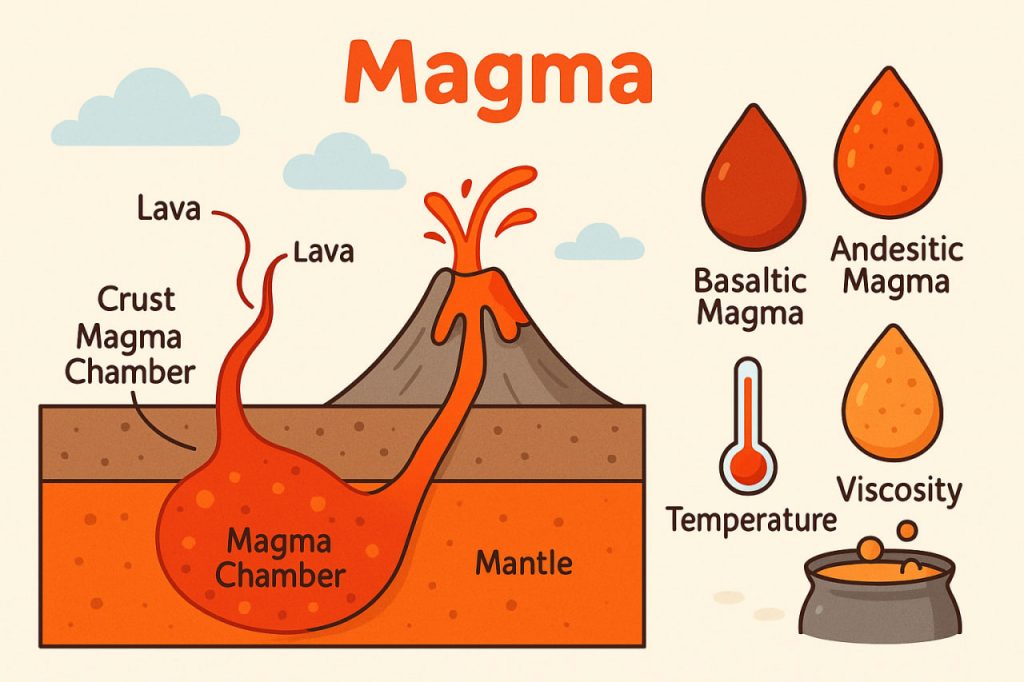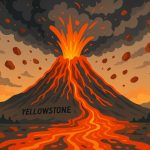Magma is molten or partially molten rock located beneath the Earth’s surface. It forms deep underground where high temperatures and pressures cause solid rock to melt. Magma is a mixture of melted minerals, gases, and sometimes crystals. When it rises and erupts onto the surface, it becomes lava. Magma plays a key role in shaping Earth’s geology, forming new crust, fueling volcanic eruptions, and driving the rock cycle. Its composition and behavior vary depending on where and how it forms.
Formation of Magma
Magma originates in the Earth’s mantle and lower crust, where heat from the planet’s interior causes rocks to melt. This process can occur due to rising temperatures, decreasing pressure, or the addition of water, which lowers the melting point of rocks. Magma often gathers in underground chambers, where it slowly accumulates before moving upward. Its formation is influenced by tectonic activity, such as subduction zones, rift valleys, and hotspots, making it central to the study of volcanism and plate tectonics.
Composition of Magma
Magma is composed of three main components: liquid rock, solid crystals, and dissolved gases. The gases, including water vapor, carbon dioxide, and sulfur dioxide, are especially important because they influence eruption style. High gas content can make eruptions explosive, while low gas levels often lead to gentler lava flows. The balance of minerals and elements in magma also determines the type of volcanic rocks that form when it cools and solidifies.
Types of Magma
Scientists classify magma into several types based on its silica (SiO₂) content:
- Basaltic magma: Low in silica, very fluid, and produces gentle eruptions. Common in places like Hawaii.
- Andesitic magma: Medium silica content, more viscous, and associated with explosive eruptions in volcanic arcs.
- Rhyolitic magma: Very high in silica, extremely viscous, and prone to catastrophic eruptions, such as those from supervolcanoes.
These differences explain why volcanoes behave so differently around the world.
Temperature and Viscosity
Magma temperature ranges from about 700°C to 1,300°C. Basaltic magma is the hottest and most fluid, while rhyolitic magma is cooler and stickier. Viscosity, or resistance to flow, determines how easily magma moves. Low-viscosity magma produces wide lava flows, while high-viscosity magma tends to trap gases and build up pressure, leading to explosive eruptions. Understanding viscosity helps volcanologists predict eruption behavior and potential hazards.
Role of Magma in Earth’s Evolution
Magma has shaped Earth for billions of years. It forms new land by creating volcanic islands, builds mountain ranges, and recycles crust through subduction. Magma also releases gases that contribute to the atmosphere, influencing climate and life. On a planetary scale, magma is a driving force of geological change. Studying it provides insight not only into Earth’s past but also into other planets and moons where volcanic activity occurs.
Conclusion
Magma is molten rock beneath the Earth’s surface, vital to the planet’s geological processes. It forms under high heat and pressure, varies in composition, and exists in types ranging from basaltic to rhyolitic. Its temperature, viscosity, and gas content determine how volcanoes erupt and what landscapes they create. By studying magma, scientists better understand Earth’s evolution, natural hazards, and the dynamics of the deep interior.
Glossary
- Magma – molten or partially molten rock beneath Earth’s surface.
- Lava – magma that reaches the surface during an eruption.
- Mantle – the layer of Earth beneath the crust where magma forms.
- Chamber – underground reservoir where magma accumulates.
- Silica (SiO₂) – mineral component that influences magma’s viscosity.
- Viscosity – resistance of magma to flow, affecting eruption style.
- Basaltic, andesitic, rhyolitic magma – classifications based on silica content and behavior.


